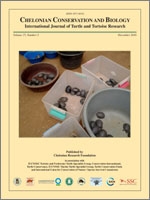Conservation of wood turtles (Glyptemys insculpta) requires improved ecological knowledge near the southern extent of their geographic range. Our objectives were to determine home range sizes and structural habitat characteristics of wood turtles near the southern border of their geographic range in eastern West Virginia. We captured 284 wood turtles (137 males, 88 females, and 59 juveniles) along a 13.7-km reach of river from spring 2009 to summer 2011. Home ranges (95% minimum convex polygons) varied from 0.62 to 36.97 ha; male home ranges tended to be elongated along the river, whereas female and juvenile home ranges encompassed a greater proportion of terrestrial habitat. Low bare ground and rock cover and high vegetative vertical density were structural characteristics associated with the turtles' habitat compared with random plots. Our study provides vital data about home range, movements, and habitat use of wood turtles along the southern border of their range. These data will assist in planning management strategies that will promote the survival and sustainability of the species. We recommend establishing and maintaining riparian zones along waterways bordering agricultural fields to provide essential habitat for the species.
How to translate text using browser tools
1 December 2016
Wood Turtle Home Range and Habitat Use in the Central Appalachians
Kathryn R.P. McCoard,
Anthony A. Billings,
James T. Anderson
ACCESS THE FULL ARTICLE
ecology
Glyptemys insculpta
habitat
home range
West Virginia





